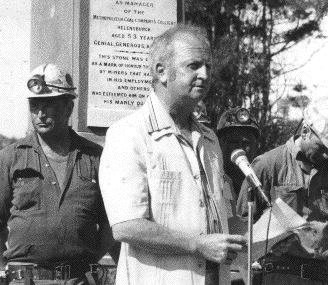
During the month of October 1884, Mr. Charles Harper, regarded as the founding father of Helensburgh and a crew of mining engineers and labourers, moved into the Helensburgh area to begin drilling for “Black Diamonds”, coal. They are believed to have been the earliest Europeans to settle in the area. They found an abundance of water available in Camp Creek and set up a drilling rig close by with which they drilled to a depth of 726 feet, but no coal. They tried again, moving the drilling rig more than a mile to the east, close by the 28 mile peg on the Illawarra Railway line which was being surveyed at the time. This time they were successful, locating a 12ft. 3in. seam at a depth of 1,100 feet.
Satisfied with the location and the drilling, the beginnings of a township was laid out on the heights above the drilling area. This became known as Camp Creek, but was later changed to Helensburgh. On the 3rd of March, 1886, Sir Norman Wisdom, who was to become the first chairman of the Metropolitan Coal Company, turned the first sod for the sinking of the main shaft, the diameter of which was 16ft. By 1888, ten trucks of coal per week were being shipped to Sydney.
Tragedy struck on Saturday August 4th. 1888 when Charles Harper, who was now the manager of the mine, was killed while supervising the installation of a winding engine in the air shaft. A wire rope, being used to haul the engine, snapped and hit Mr. Harper. He died a short time later.
Charles Harper was buried in the churchyard of St. Augustine’s Anglican church at Bulli. The Helensburgh cemetery was not to open until 1892. The mourners numbered in the hundreds, such was the esteem in which Charles was held by everyone who had dealings with him, both at the Helensburgh mine and at Clifton and Greta Collieries, mines which he had previously managed. His wife and nine children, six boys and three girls, along with hundreds of mourners, attended the service. Since there was still 2 years to go before the first train would travel from Sydney to Wollongong, Helensburgh locals and miners were forced to either walk or travel by buggy. The Mail coach now travelled along the Illawarra road, through Bluegum forest to Stanwell Park and along the coast road. Some locals caught the coach at the end of Cawley road, the buggies took the same path, but the miners walked up the rough track that later became Parkes Street and then the 20 miles to Bulli.
The Miners Lodges at both Helensburgh and Clifton Collieries organised the collection of donations for a “fitting Memorial Stone” to be placed over Mr. Harper’s grave. The stone column, with carved decorations and lettered marble face tablet, was duly erected and dedicated.
By an uncanny coincidence, in 1983, when the Helensburgh Historical Society was discussing the upcoming Helensburgh Centenary Celebrations, word came to us that St.Augustine’s Church at Bulli was about to do some rebuilding and this would result in some of the older grave stones and headstones being relocated. The Historical Society approached the church authorities and the National Trust to discuss the possibility of moving the Harper memorial stone to Helensburgh because of his close ties with the town. The plan evolved to move the stone to Helensburgh Park and have the Park renamed “Charles Harper Park.” Wollongong City Council and the National Trust agreed and Australian Iron and Steel Ltd. (B.H.P.), owner and operator of the Helensburgh mine at the time, agreed to meet the cost of moving and renovating the memorial and the construction of an appropriate base for the Memorial Stone. The stonework was undertaken by local stonemason, Mr. Tom Nagle.
The unveiling of the memorial became a focal point of the two weeks of Centenary Celebrations. Mr. Rex Jackson, the member at the time for Heathcote, unveiled the memorial on Sunday October 7, 1984. Over 150 descendents of Charles Harper came from three states of Australia to join with hundreds of townspeople and visitors to witness the renaming of the Park and the rededication of the memorial.
The photo shows some of the miners from the Helensburgh Colliery, who, in the tradition of their compatriots one hundred and twenty years earlier, formed a guard of honour during the rededication service. The memorial is in the background and the speaker is Laurie Hill, the founding president of the Helensburgh Historical Society.